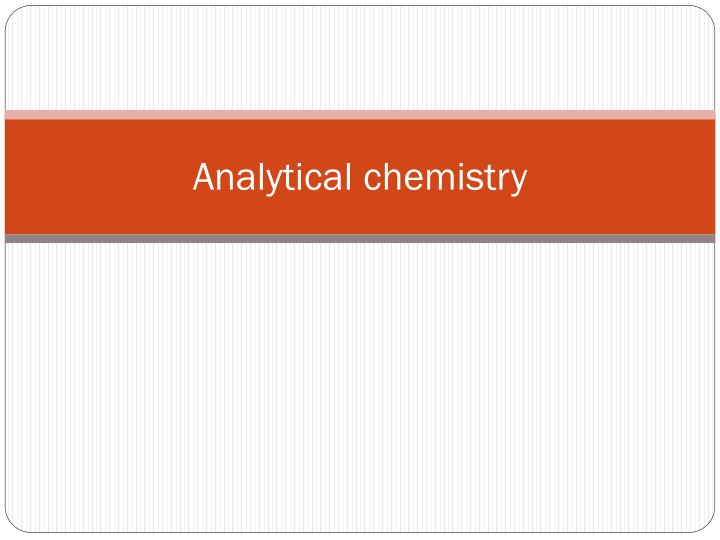Introduction to Analytical Chemistry and pH Detection
Analytical chemistry involves the study of detecting acids and bases in solutions, with methods such as litmus testing and the Arrhenius definition. The concept of conjugate acids and bases, acid dissociation, and buffer solutions are also key components in understanding chemical properties and reactions in the laboratory.
Download Presentation

Please find below an Image/Link to download the presentation.
The content on the website is provided AS IS for your information and personal use only. It may not be sold, licensed, or shared on other websites without obtaining consent from the author.If you encounter any issues during the download, it is possible that the publisher has removed the file from their server.
You are allowed to download the files provided on this website for personal or commercial use, subject to the condition that they are used lawfully. All files are the property of their respective owners.
The content on the website is provided AS IS for your information and personal use only. It may not be sold, licensed, or shared on other websites without obtaining consent from the author.
E N D
Presentation Transcript
pH In the laboratory, we can detect acids and bases in solution in several ways. Perhaps the simplest test uses a substance called litmus, a natural dye derived from lichen. It acidic conditions and blue in basic conditions turns red in
Conjugate acid base Conjugate acid that forms when one H ion is added to a molecule or ion. ion is removed from Conjugate base the molecule or ion that forms when one H a molecule or ion lost. the molecule or ion
Buffer solution : A buffer solution is an aqueous solution consisting of a mixture of a weak acid and its conjugate base or a weak base and its conjugate acid. It has the property that the pH of the solution changes very little when a small amount of strong acid or base is added to it. Buffer solutions are used as a means of keeping pH at a nearly constant value in a wide variety of chemical applications
Hasselbalch equation is derived from the acid dissociation constant equation by the following steps : The Henderson
Acid base balance in blood Buffer solutions are necessary to keep the correct pH for enzymes in many organisms to work. Many enzymes work only under very precise conditions; if the pH strays too far out of the margin, the enzymes slow or stop working and can denature, thus permanently disabling their catalytic activity.[1]A buffer of carbonic acid (H2CO3) and bicarbonate (HCO3 ) is present in blood plasma, to maintain a pH between 7.35 and 7.45.
Carbonic acid is an intermediate step in the transport of CO2out of the body via respiratory gas exchange. The hydration reaction of CO2is generally very slow in the absence of a catalyst, but red blood cells contain carbonic anhydrase, which both increases the reaction rate and dissociates a hydrogen ion (H+) from the resulting carbonic acid, leaving bicarbonate (HCO3-) dissolved in the blood plasma. This catalysed reaction is reversed in the lungs, where it converts the bicarbonate back into CO2and allows it to be expelled. This equilibration plays an important role as a buffer in mammalian blood Dialysis in living system
Electrolyte and non-electrolyte solutions: Aqueous solutions either conduct electricity or they not , if they conduct electricity are called electrolytic solution if the not are called non electrolytic solution . Aqueous solution : The solution in living systems are aqueous solution , that is are made with water. Solubility : The amount of solute that dissolves in a given quantity. Solute are more soluble in hot than cold solvents .
Dialysis Dialysis in living Kidney are an example of organ in body that use dialysis to maintain the solute and electrolyte balance of the blood. In 68 kg adult 180 liter of blood purified to about 99.0 % and 1% remaining.
Dialysis works on the principles of the diffusion of solutes and ultrafiltration of fluid across a semi-permeable membrane. Diffusion describes a property of substances in water. Substances in water tend to move from an area of high concentration to an area of low concentration. Blood flows by one side of a semi-permeable membrane, and a dialysate, or special dialysis fluid, flows by the opposite side. A semipermeable membrane is a thin layer of material that contains various sized holes, or pores. Smaller solutes and fluid pass through the membrane, but the membrane blocks the passage of larger substances (for example,red blood cells, large proteins).
Crenation in red blood cells. Red blood cells when placed in saline (NaCl), the solution inside the cell is hypotonic compared to the saline solution and osmosis reverse direction , water leave the RBCs to solution that lead to shrink . this process is called crenation.























